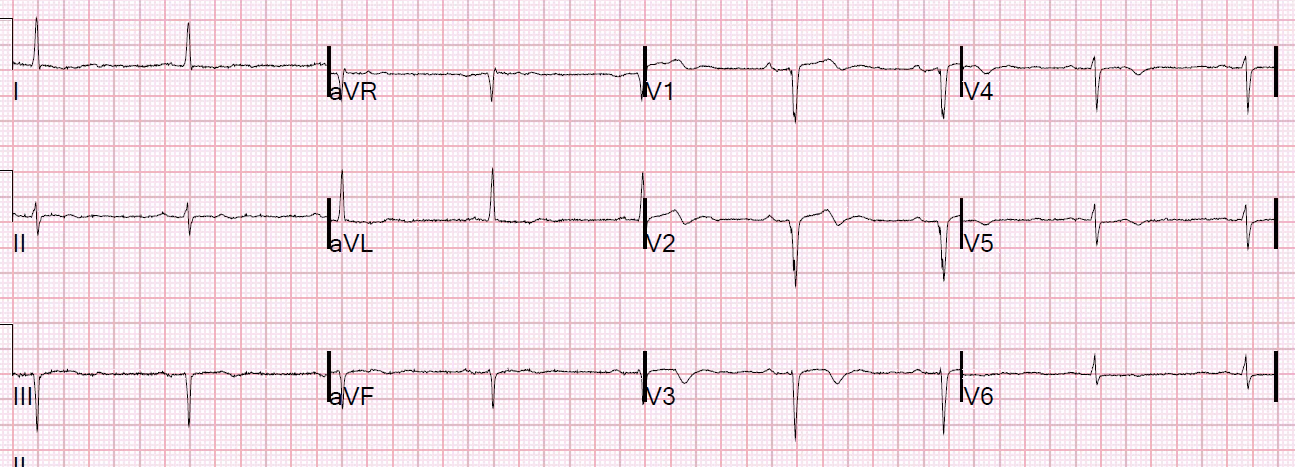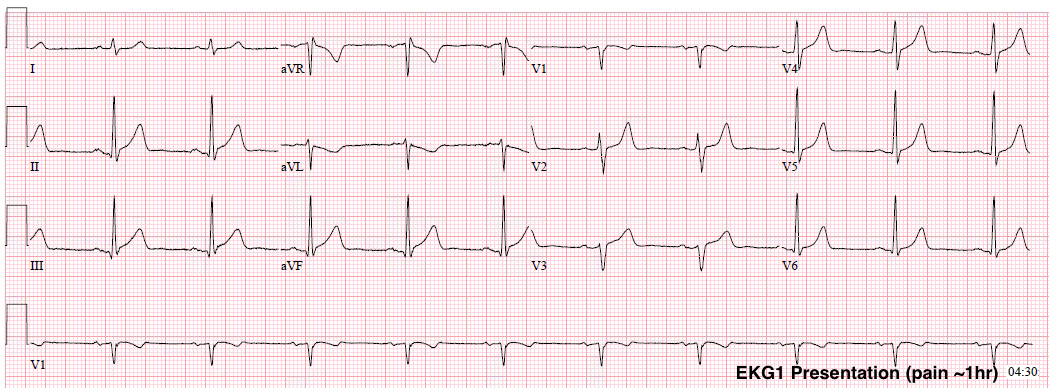A very elderly man fell and injured his face. There is always the possibility of syncope as the etiology of a fall, especially in an elderly person.
I was consulted on his ECG.
He had no chest pain, nor chest pain shortly before presentation.
 |
| What do you think? This is what the treating physicians wrote: “Syncope workup notable shows abnormal EKG with Wellens’ waves in V2 and V3.“ |
My opinion was this:
“There are no R-waves in V2 and V3, so it is not Wellens’. Furthermore, it can’t be Wellens’ syndrome even if the ECG is true Wellens’ morphology: Wellens’ syndrome requires that the ECG be recorded after an episode of chest pain that is now resolved. This patient had no pain at any time.”
I asked:
“Is there a previous ECG for comparison?” (No, there was not)
Continued
“The QS-waves and shallow T-wave inversion are typical of a dense old transmural anterior MI, and may represent an aneurysm of the LV anterior wall. There could be some acute NonSTEMI superimposed on old MI, but the ECG does not make me worried for LAD acute coronary syndrome and not for acute coronary occlusion. If these T-waves are due to acute ischemia, then the troponin will be positive. So just get serial troponins.”
Outcome
The patient ruled out for MI, with all troponins below the level of detection.
A previous echocardiogram was found, which showed
Regional wall motion abnormality-distal septum, anterior and apex, hypokinetic, large.




This comment has been removed by the author.
1) V1-V3: biphasic T waves with (prominent) U waves ? (Kalium ?)
2) T-V1 taller than T-V6 (Marriott, 1962)
3) A bit of QRS-fragmentation in V1-V2 ?
merci Dr Smith !!
Al
AVB 1º grade + LEFT BRUNCH ANTERIOR BLOQ = BIFASCICULAR BLOCKING SUGGESTIVE SYNCOPE,FALL
Thanks for the interesting case (and blog)! Is there a minimum amplitude criteria for the r-wave? From my experience it is common with a small positive deflection as seen in V3 (and V2 to some degree) preceding the QS-complex. This has sometimes
made me wonder whether there are q-waves or not.
Thanks for an interesting case (and blog)! From my experience it is common with a small positive deflection preceding the Q-wave as is seen in v3 (and v2 to some degree). Sometimes it can be quite big which have made me wonder whether there are q-vawes or not. Do you have any thoughts on how large the deflection would be to still call it a qs-complex?
very interesting, stephen
GREAT case about a common primary care (as well as emergency care) issue! As per Dr. Smith, this ECG is not acute — but it most definitely suggests prior injury/infarction. In addition to lacking a history of chest pain — this tracing is not “Wellens Syndrome” because the infarction appears to have already taken place, given the QS we see in V1,V2 and no more than very tiny initial r in V3. Moreover, there appears to be initial slurring of the downslope of the S wave in V1,V2 (if not with some notching) — which are features suggesting these complexes do indeed indicate prior scar from previous infarction. What remains unknown from looking at the ECG alone, is WHEN the anterior injury occurred. Potentially it was a couple days earlier (in which case the anterior chest lead ST-T wave changes could represent a “subacute” reperfusion pattern) — or it could have been many days, weeks, months or longer in the past. Here is where History becomes tremendously important! The Framingham studies taught us that as many as 1/3 of all infarcts are “silent” — that is not accompanied by chest pain. Of this number, about half of the 1/3 were totally “silent” (ie, NO symptoms at all) — and the other half had “other” symptoms (ie, not chest pain — but abdominal pain, shortness of breath, general malaise and/or mental status changes). If one carefully asks a mentally competent patient to “Think back” over recent days, weeks, months to anything that might possibly represent an “event” (ie, a couple of days when you just didn’t feel right; perhaps had some chest discomfort or unexplained “flu” symptoms) — you’ll often be rewarded by suggestion in this retrospective history of something that might point to an onset of what in this case was a large anterior infarction that this patient evidently had in the past.
Acute ischemia is the most common single reason for elevated troponin.
Je vous en prie!
Well, that's possible. Only single fascicle, and even that is very questionable, as there is no q-wave in aVL or r-wave in III.
By the Minnesota Code, a 0.5 mm r-wave is coded as a Q-wave. It is a Q-wave equivalent.
Thanks, Ken!
Karl,
less than 1 mm is considered a Q-wave.
Steve Smith
Concern for hypoK/long QT here? Rate is only about 50 too. Would definitely at least get a K value, if history suspicious for syncope, I'd be worried about TdP.
Maarten Van Hemelen
I. M. Resident
Good thought. There are also very large U-waves. And long QT would be of higher risk in the setting of old anterior MI. However, it was almost certainly a mechanical fall. K was normal.
Hi Dr. Smith! Does a patient with Wellen's Syndrome on EKG and a concerning history (recent chest pain assoc with diaphoresis, sob, and near syncopal episode) need emergent cath? Or can they get urgent cath (like the next day)? At my old hospital where I did residency, these people would go straight to cath lab. But at the hospital I'm working at now, they wanted her to go to the floor and have ACS rule out and likely cath in the morning. Thank you for your insight 🙂
Good question. I would recommend immediate cath, but since the artery is open (or there is good collateral circulation), it is not absolutely essential. However, reocclusion can be asymptomatic, so I always recommend: aggressive antiplatelet and antithrombotic therapy and continuous 12-lead ST segment monitoring. See these 2 cases: https://hqmeded-ecg.blogspot.com/search/label/ST%20Segment%20Monitoring
Great comments Ken